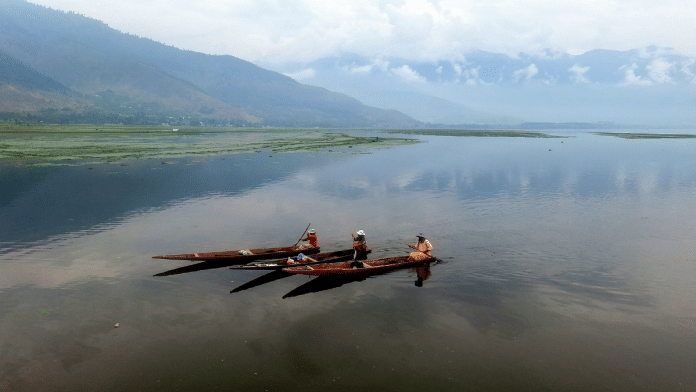New Delhi: The Centre is working to revive the Tulbul navigation project on the Wular Lake in Kashmir given that the restrictions related to water use are in abeyance with the Indus Water Treaty (IWT) on hold, ThePrint has learnt.
The project, which envisages constructing a 439-ft long and 40-ft wide barrage with a storage capacity of 0.30 million acre feet (MAF) below the Wular Lake near Ningli to stabilise Jhelum’s water level, was abandoned midway in 1987 after strong objections from Pakistan. Civil works, including concrete piling and foundation works on the left bank were already completed by then.
Two senior government officials aware of the development told ThePrint that following a series of meetings with all stakeholders, including Jal Shakti and power ministries last month, to discuss ways to better harness waters from the Indus river system, it was decided to revive the Tulbul project.
“NHPC, a public sector utility under the power ministry and India’s largest hydropower organisation, has been directed to do a pre-feasibility study of the Tulbul project and submit its report in the next three months,” one of the senior government officials said.
The official added that a final call would be taken after NHPC submits its report. “We were told that civil work was done till 1987 when the project was abandoned with foundation works more or less intact. Once NHPC submits its report, a call will be taken on how to go ahead,” the official said.
Had the barrage been completed earlier, it would have regulated the water of the Wular Lake to maintain a minimum draft of 4.4 ft in the river up to Baramulla during the winter season. This minimum draft would have ensured round-the-year navigation over a 20-km stretch between Baramulla and Sopore.
It would have also provided water and helped in firming up power generation in downstream hydroelectric plants such as the Uri and Uri I hydro projects in India as well as other hydro projects downstream in Pakistan during the lean season.
Last month, Jammu and Kashmir Chief Minister Omar Abdullah had put a picture of Wular Lake on the social media platform ‘X’ and wondered if work would be resumed now that India has put the IWT on hold. Abdullah’s tweet got mired in a political controversy after his rival and Peoples Democratic Party (PDP) chief Mehbooba Mufti accused him of making “irresponsible” and “dangerously provocative” statements.
The Tulbul project was abandoned after Pakistan objected on the ground that it involves construction of a barrage with a storage capacity of around 0.3 million acre feet (0.369 billion cubic metre) and under the provision of IWT, India is not permitted to construct any storage facility on the main stem of the Jhelum.
In August 2006, Saifuddin Soz, the then water resources minister, in a written reply in Lok Sabha, said that Wular Lake gains natural storage and that the navigation lock is merely a structure to regulate the outflow from the natural storage to facilitate adequate depth of water for navigation during the winter months from October to February.
Brokered by the World Bank in 1960, the IWT allows India unrestricted rights over water of the three eastern rivers on the Indus basin—Ravi, Beas, Sutlej, which is approximately 20 percent of the water carried by the Indus system. Pakistan is allowed unrestricted use of waters on the three western rivers—Indus, Jhelum and Chenab, which is roughly 80 percent of the water carried by the Indus system.
The IWT further states that India may use the waters of the three western rivers in “non-consumptive” ways, including for domestic and agricultural use and run of the river hydroelectric power to generate electricity, subject to design and operation criteria set.
(Edited by Tony Rai)
Also Read: India starts flushing Baglihar, Salal reservoirs in move set to impact kharif sowing in Pakistan







IWT is history. Pakistan wants to treat India as a perennial enemy of kafirs. Only Indians are still infatuated with IWT on moral terms. Keeping the Indus waters in India will put a leash on Pakistan’s hate towards India and make it see reality.